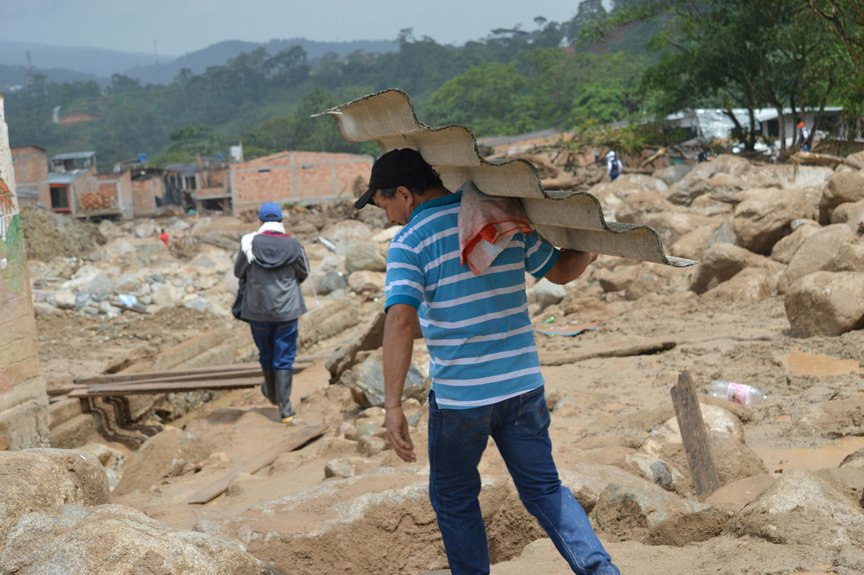If your roof in Guthrie, OK, takes a hit during a storm, you need to act quickly but carefully. You’ll want to assess the damage without risking your safety, document everything, and take steps to prevent further issues. Knowing when to call a professional and how insurance fits into the process can save you time and money. But what exactly should you look for first, and how do you prioritize your next steps?
Assessing Roof Damage After a Storm
Although it can be tempting to inspect your roof immediately after a storm, you should prioritize safety and wait until conditions are secure.
When conducting a visual inspection, focus on common damage indicators such as missing or cracked shingles, damaged flashing, and debris accumulation.
Check for water stains or wet spots inside your attic, which may signify leaks. Pay attention to gutters and downspouts, as their condition can reveal impact damage.
Use binoculars to examine hard-to-reach areas without climbing onto the roof. Document all visible damage with photos to assist with insurance claims.
For urgent repairs or professional evaluation, contacting storm damage roof repair specialists promptly can help minimize further damage.
Immediate Safety Measures for Storm-Damaged Roofs
After a storm damages your roof, taking three immediate safety measures can protect you and your property from further harm.
First, inspect your roof cautiously from the ground, avoiding unsafe areas to prevent injury.
Second, secure the property by covering exposed areas with tarps or plastic sheeting to prevent water infiltration. These emergency repairs minimize additional damage until professional help arrives.
Third, clear your yard of debris that could cause hazards or damage during cleanup.
Always prioritize safety precautions; never climb on a compromised roof or attempt major repairs yourself.
These steps help stabilize the situation, protect your home, and reduce risks associated with storm damage. Acting swiftly and carefully guarantees you maintain control and safety in the aftermath of severe weather.
When to Contact a Professional Roofing Contractor
How do you know when it’s time to call a professional roofing contractor? After a storm, if you notice missing shingles, leaks, or visible structural damage, it’s crucial to schedule a roof inspection promptly.
Even if damage seems minor, a thorough inspection can identify hidden issues that could worsen over time. When selecting a contractor, prioritize experience, proper licensing, and positive reviews to guarantee quality repairs.
Avoid attempting DIY fixes, as improper repairs can lead to costly problems. A professional contractor not only assesses damage accurately but also guides you through repair options tailored to your roof’s needs.
Timely contractor selection and roof inspection protect your home’s integrity and help you avoid extensive future damage. Don’t delay—reach out as soon as storm damage is suspected.
Understanding Your Insurance Coverage for Roof Repairs
What does your insurance policy cover when it comes to roof repairs? Understanding your coverage is essential after storm damage.
Most policies cover sudden, accidental damage caused by storms, like hail or wind, but may exclude wear and tear or maintenance issues. Review your insurance policy carefully to identify covered perils and any deductibles.
When filing a claim, document the damage thoroughly with photos and detailed notes to streamline the claim process. Contact your insurance agent promptly to report the damage and clarify policy specifics.
Knowing these details helps you avoid unexpected expenses and guarantees a smoother claim process. If you’re unsure about your coverage, don’t hesitate to ask your insurer or a professional roofer for guidance to protect your investment effectively.
Preventative Tips to Protect Your Roof From Future Storms
Because storm damage can lead to costly repairs and safety hazards, taking proactive steps to protect your roof is crucial.
Start by scheduling regular roof maintenance to identify and address minor issues before they escalate. Inspect shingles, flashing, and gutters for wear or damage, especially after harsh weather.
Implement weatherproofing techniques such as applying sealants and reinforcing vulnerable areas to prevent water infiltration and wind damage. Trim overhanging branches to reduce the risk of falling debris during storms.
Ascertain proper attic ventilation to avoid moisture buildup that can weaken roofing materials.
Conclusion
After a storm, promptly assess your roof for damage using binoculars and take clear photos. Secure exposed areas with tarps but avoid climbing on a compromised roof to stay safe. Contact a professional roofing contractor for a thorough inspection and check your insurance policy to understand your coverage. Taking these steps guarantees you handle storm damage effectively and protect your home. Stay proactive with preventative maintenance to minimize future risks. For more information on how to schedule your free roof inspection call us at (405) 543-2920 or visit us online at Top View Roofing.











